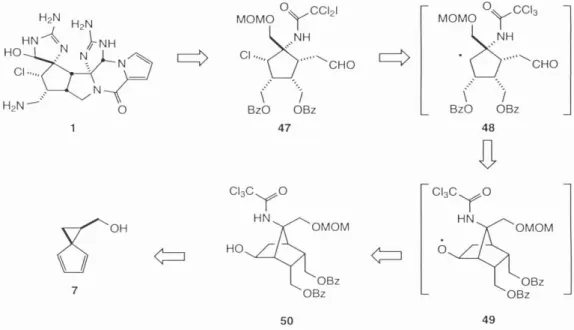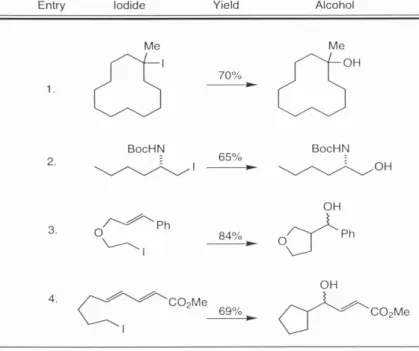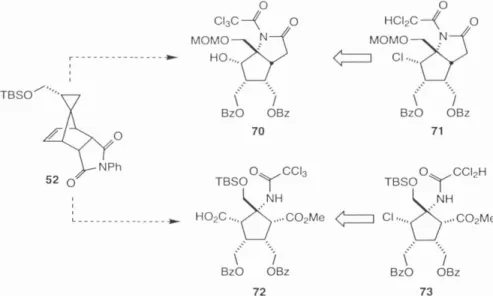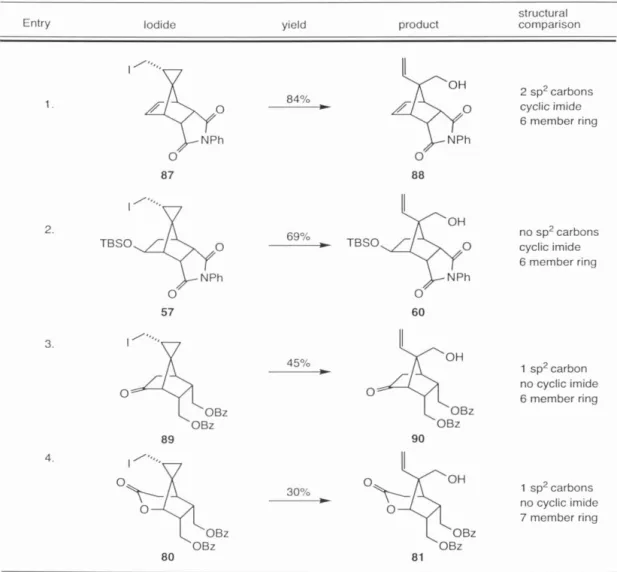His enthusiastic teaching and consistently high expectations inspired me to learn and achieve more than I thought I could. While my father was at work, my mother taught me to read, write and count.
General Introduction
H0~ 0 'Pr/-f--r H02C CHO
Scheme 1
When X=TMS, alternative stereochemies were accessible via mild base-promoted epimerization (K2CO3) of the aldehyde groups, exemplified by 18. The sum of the work presented herein supports the hypothesis that 7 can be used as a general scaffold for the stereoselective synthesis of .
TIPSONH
Progress towards the synthesis of the phakellin moiety of 1 was realized by Bi.ichi 17 over a decade before palau'amine 1 was discovered (Scheme 7). Any approach to the synthesis of 1 would have to take into account the severe steric demands of the cyclopentane ring 46.
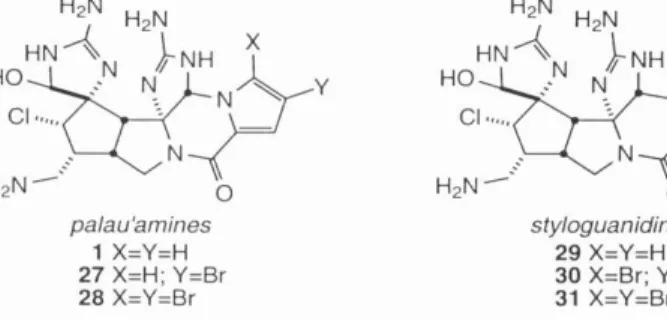
6: ' CHO
The balance of the material, obtained by evaporation of the mother liquor, was then heated to reflux in chlorobenzene (PhCl) to induce retro-Diels-Alder and regeneration of the 1:1 diastereomeric mixture from which an additional crop of 52 could be obtained . by recrystallization. Koch then sought to demonstrate the potential of the stereogenetic carbon on the cyclopropyl ring to control functionalization of norbornene 52 .
TBSO/~
Carreira and Ledford previously reported the synthesis of non-racemic diene 7 in 91% ee from enantiomerically pure epichlorohydrin in the context of their synthesis of trehazoline 8.6 This report highlighted the attractiveness of 7 as a general precursor and its ease of synthesis and readiness greatly expanded availability of both enantiomers of epichlorohydrin in pure form made it an ideal starting material for the palau'amine studies. Only modest selectivity was observed in the formation of desired primary iodide 58 over the undesired iodide 59 and the ratio of products varied from I:I to 4:I with an overall yield ranging from 50-80%.
TBS~~
To our knowledge, this method has not previously been used for the formation and fragmentation of a cyclopropylcarbinyl radical. Bu3SnH in heavily aerated toluene leads predominantly to the desired cyclopropylcarbinyl radical fragmentation product 60 after complete reduction of the corresponding intermediate hydroperoxide with added PPh3 (Scheme 10).
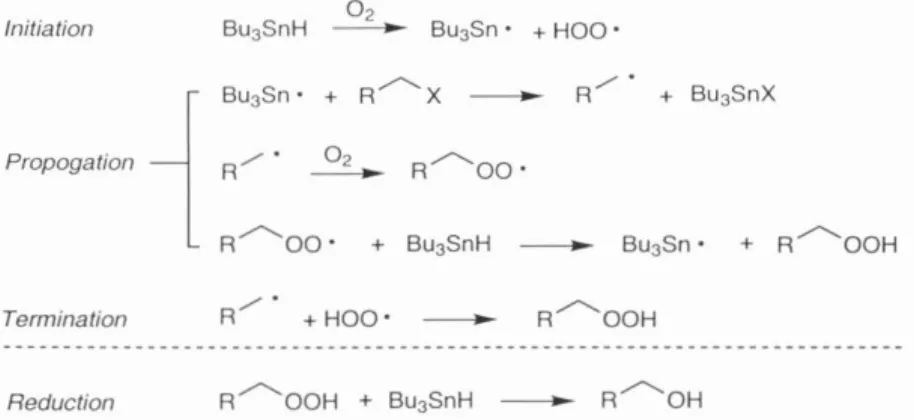
Hydrogenolytic removal of the Cbz protecting group was achieved with Iatm H2 and Pearlman's catalyst (Pd(OH)2)34 and the resulting amine was immediately acylated with trichloroactyl chloride and TEA to give trichloroacetamide 69 in 65% yield for the two-step sequence (Scheme 13). Desilylation of the TBS ether with HF-pyridine afforded the desired chlorine transfer precursor 50 in 86% yield.
The identity of the major isomer of 76 was confirmed by comparison with authentic material prepared from 55 (Scheme 9). Silylation of 88 in DMF using TBSCI and TEA was followed by LiOH hydrolysis of the imide and closure to the anhydride in an overall yield of 87% for the three steps.
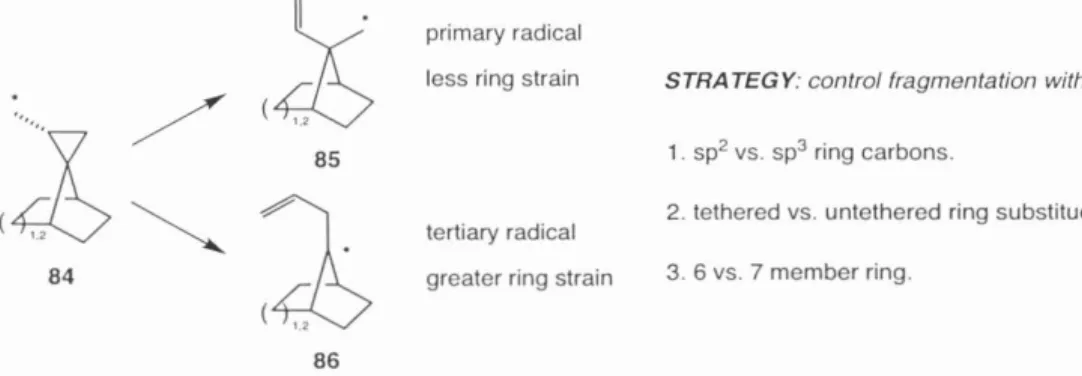
TBS ~TBS
Thus, selective oxidative cleavage of the terminal olefin of 95 was investigated using osmium tetroxide as the active oxidant. Attempted periodate cleavage of the dihydroxylation product under neutral or unbuffered conditions resulted in the formation of a mixture of 96 and a hydroxyaldehyde byproduct.
HO~OTBS
Finally, after learning some of the pitfalls of this system, a successful route to 72 was devised. Oxidation of the amino-imidazole function followed by intramolecular nucleophilic attack of the guanidine would then give the axinellamines 2-5.
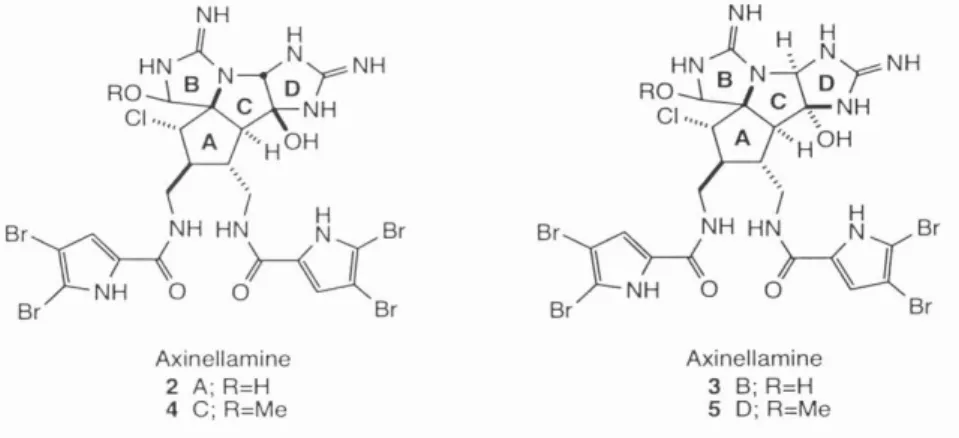
CIKCHO)
Finally, the use of the successful functional group manipulations elaborated in the palau'amine study for late-stage processing of the axinellamine core promised a higher probability of success in this route. In case, treatment of 93 with methanol in 1:1 toluene/CCI4 in the presence of l eq.
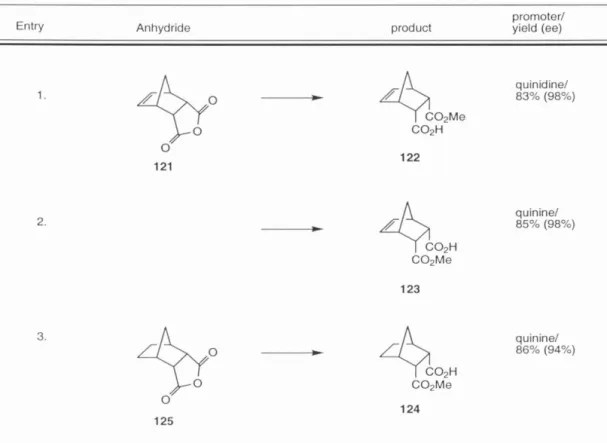
OTBS
Single crystal X-ray diffraction analysis of 127 confirmed its constitutional structure as well as relative and absolute stereochemistry ( Figure 12 ). The absolute configuration of 127 was (2S, 3S), indicating the formation of the (2R, 3S) acid ester in the Bolm methanolysis and consistent with Bolm's report of the stereochemical bias conferred by the quinine promoter.51.
General Conclusion
Investigations into the potential of spiro[2.4]hepta-4,6-diene-1-methanol 7 as a general scaffold for the synthesis of functionalized cyclopentane substructures of synthetic utility led to the discovery of a new homoconjugate addition to an activated cyclopropane, the study of a highly functionalized cyclopentyl intermediate en route to palau'amine, and the enantioselective synthesis of the fully functionalized axinellamin core. Next, 7 was implemented as a starting material in the synthesis of the extended natural product palau'amine 1. The mode of radical fragmentation of the cyclopropane ring was highly dependent on the type of substitution on the ring system.
Finally, the studies of 7 culminated in the first successful synthesis of functionalized dense core axinelamines A–D 2–5 . This approach allowed the advancement of synthesis with achiral intermediates accessible in large quantities before asymmetry was introduced. The identity and relative stereochemistry of nucleus 153 was confirmed by NMR and mass spectral methods.
Experimental Procedures
Chromatographic purification of the products was performed on Baker 7024-R silica gel, EM Science Geduran 60 silica gel, or Fluka Silica Gel 60 using a forced flow of EtOAc/hexanes eluent (unless otherwise noted) at 0.1–0, 15 bars. Thin-layer chromatography was performed using Merck Silica Gel 60 F2s4 TLC plates and visualized by fluorescence quenching under UY light. Data for 1 H-NMR spectra are reported as follows: chemical shift relative to tetramethylsilane (o in ppm), multiplicity (s, singlet; d, doublet; dd, doublet doublet; m, multiplet), integration, constant of coupling (J in Hz).
IR spectra were recorded on a Perkin Elmer Spectrum RXI FT-IR spectrometer or paragon 1000 FTIR spectrometer using NaCl salt plates and are reported in tens of frequency of absorbance (v, cm-1). Unless otherwise stated, reactions are assumed to be at equilibrium temperature with the external environment and are reported in terms of the composition of the external bath as follows C" indicates acetone/dry ice suspension C" indicates ice/salt melt; "0 °C" indicates water/ice melting; "23 °C" indicates ambient air temperature. Solvent removal in vacuo afforded an oil which was purified by chromatography on silica gel (hexanes: EtOAc 20:I).
NMR 75 MHz
The combined extracts were dried over Na 2 SO 4 and concentrated in vacuo to give the desired product as a colorless oil in quantitative yield. The mother liquor was concentrated in vacuo and the residue was dissolved in 500 ml of chlorobenzene. After stirring at reflux for 24 h, the solvent was removed in vacuo and the residue was recrystallized again from cyclohexane.
The combined organic layers were washed 5 x 100 mL 1N NaOH, dried over Na 2 SO 4 , and concentrated in vacuo. After stirring at 23 o C for 2 h, the reaction mixture was concentrated in vacuo to a total volume of 150-200 mL. Triphenylphosphine (511 mg, 1.95 mmol) was added and the resulting mixture was stirred for an additional 30 min, then concentrated in vacuo.
The solvent was removed in vacuo and the residue was purified by chromatography on silica gel (1:1 hexanes/EtOAc) to give 0.578 g (69%) of 60 as a colorless solid containing ca. The combined organic layers were dried over Na 2 SO 4 and the solvent was removed in vacuo.
C~02C OMOM
The resulting mixture was stirred for 1 h at 23 °C, then the solvent was removed in vacuo and the residue was dissolved in Cl-{zCb, washed with 50 mL of I N Nal-IS04 and dried over Na2SO4. The solvent was removed in vacuo and the residue was purified by chromatography on silica gel (2:1, hexanes/EtOAc) to give 0.0253 g (86%) of 50 as a white solid. The combined filtrates were evaporated in vacuo to give the desired diol 75 as a colorless solid that was purified by recrystallization from hexanes.
The combined organic extracts were dried over sodium sulfate and concentrated in vacuo to give a colorless solid mixture of regioisomeric triols 76 in a 3:1 ratio (as determined by 1H-NMR). Concentration in vacuo afforded a colorless solid which was purified by chromatography on silica gel (3:1 hexanes/EtOAc) to afford 0.112 g (82%) of a 5:1 mixture of isomers 80 as a colorless solid. Partial removal of the solvent in vacuo gave a viscous solution which was chromatographed on silica gel (1:1 hexane/EtOAc) to afford 87 as a colorless solid.
Removal of the solvent in vacuo gave 92 as an orange oil, which was purified by silica gel chromatography (4:1 hexanes/EtOAc) to give pure 92 as a colorless solid. Removal of the solvent in vacuo gave a colorless solid which was dissolved in 700 mL of toluene at 23 °C.
YOTBS
The mixture was extracted 2 x 100 mL EtOAc and the combined organic layers were washed 1 x 100 mL 1-hO, 1 x 100 mL brine and then dried over sodium sulfate. Evaporation in vacuo afforded a green oil which was chromatographed on silica gel (1:1 hexanes EtOAc) to give. Evaporation in vacuo followed by chromatography of the residue on silica gel (4:1 hexanes/EtOAc) gave 0.792 g (93%) of 96 as a colorless solid.
HO~KOTBS
OC;~OTBS
The reaction was heated to 100 °C for 1 h, after which the solvent was distilled off under hivac (<1 torr) to give an orange gelatinous residue which was subjected to silica gel chromatography (4:1 hexanes/EtOAc) to give 0.532 g (93 %) of 91 as a colorless foam. The reaction mixture was purged with N2 until it became colorless, then it was warmed to 23°C and the solvent was removed in vacuo. Removal of solvent in vacuo followed by silica gel chromatography (7:1 hexanes/EtOAc) afforded 0.251 g (51%) of 100 as a colorless foam.
Removal of the solvent in vacuo gave a colorless oil which was purified by silica gel chromatography (3:1 hexanes/EtOAc) to give 0.0 16 g (40% of 100) of 72 as a colorless film. Removal of the solvent in vacuo gave a quantitative return of the cis acid ester 126 as a colorless oil, which was used without further purification ([a]Na -2.13 (c = 0.825, CDCb)). Removal of the solvent in vacuo gave the acid ester 16 as a yellow oil, which was purified by chromatography on silica gel (30:1 CH2Cb/HOAc) to give 1.64 g (73%) of pure 127 as a colorless oil, which crystallized during the state.
CONH2
The reaction was stirred for 5 minutes and then quenched by adding 5 ml of pH=7 buffer (1.25 M phosphate) and warming the reaction to 23°C. The reaction mixture was allowed to warm to room temperature and after 1.5 h was cooled again with an ice bath and sequentially treated with 0.3 mL of water (gas evolution!), 0.3 mL of 15% NaOH, and 0.9 mL of water . It was then extracted with 3 x 50 mL CH 2 Cl 2 and the combined organic layers were dried over Na 2 SO 4 . Concentration in vacuo gave an oil which was purified by silica gel chromatography (1:1 CH 2 Cl 2 /EtOAc) to give 1.31 g (98%) of a 6:5 mixture of two diastereomeric discs.
Concentration in vacuo followed by purification by chromatography on silica gel (1:1 hexane/EtOAc) afforded 0.900 g (92%) of aldehyde 137 as a colorless foam. Gas evolution was observed and the reaction mixture was stirred for 1.5 h, then concentrated in vacuo to give a yellow solid residue. Concentration in vacuo gave a yellow oily residue, which was redissolved in 15 mL of benzene and heated to reflux for 2 h. Completion of the reaction was determined by FTIR, as evidenced by the disappearance of N3 stretching and the appearance of NCO stretching.).



